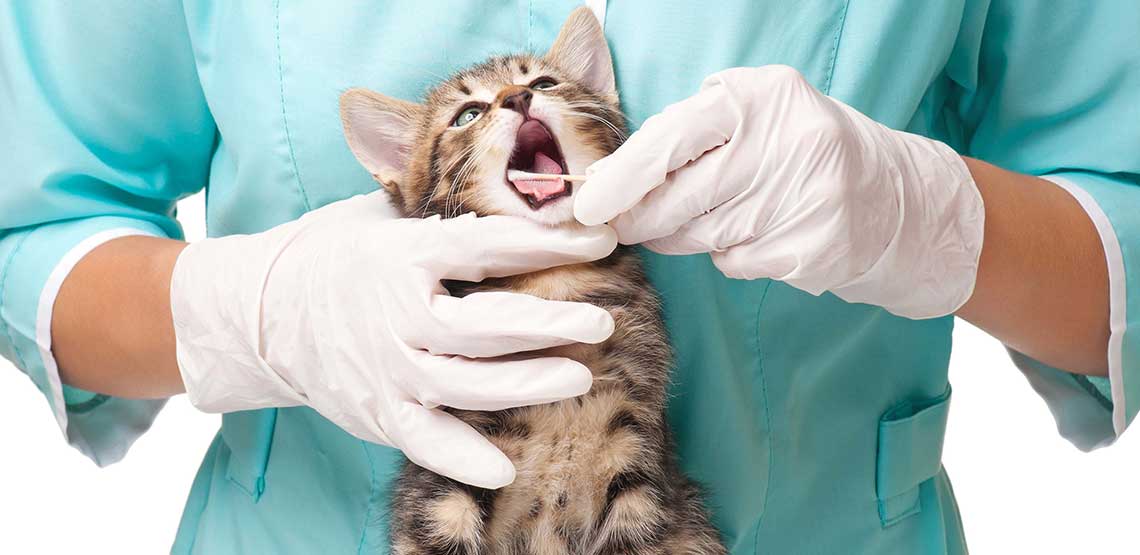Feline Dental Care
Cat dental health is one of the most overlooked aspects of cat health care. As a result, the American Veterinary Dental Society reports that approximately 70 percent of cats show signs of a cat dental problems by the time they reach the age of three. In order to maintain good oral hygiene and limit dental problems, cats require specialized cat dental care both by a veterinarian and at home. Undetected cat dental disease can cause tooth loss and may lead to serious heart, lung or kidney issues.
Common Cat Dental Problems
- Gingivitis. This is a reddening and inflammation of the gums caused by bacteria in plaque. If gingivitis is left untreated, it can lead to periodontal disease.
- Gingivitis-stomatitis. This disease includes not only gingivitis (inflammation of the gums) but stomatitis (inflammation of the mouth lining). This may be caused by viral infections, chemical irritation, injury, chronic renal failure, feline diabetes or periodontal disease. It is painful and often chronic.
- Periodontal disease. This is the most common oral disease found in cats. It is a disease of the tissues that surround and support the teeth and is treatable in the early stages. It is caused by excess plaque on the teeth which host bacteria, and it often results tooth loss if left untreated.
- Infection. An infected tooth can leak bacteria into the bloodstream. These bacteria can cause heart, lung, kidney or liver issues.
- Fractured teeth. Teeth broken by trauma can lead to infection and be very painful for your cat.
Signs and Symptoms of Cat Dental Problems
- Halitosis (bad breath)
- Yellow/brown tartar buildup along the gum line
- Red, inflamed gums and mouth lining
- Receding gums
- Excess saliva or drool (may be bloody or tacky/sticky)
- Lack of appetite
- Weight loss
- Pawing at the mouth, or rubbing the side of the mouth along the ground, indicates potential pain
- Difficulty chewing
- Inability to close the mouth
You May Also Like:
Related Search Topics (Ads):
Treating Cat Dental Health Problems
- Professional dental cleanings may require your cat be anesthetized or sedated.
- Cleaning is done with a scaler to remove any plaque both above and under the gum line.
- X-rays may be needed to determine the severity of the cat dental health problem.
- A mouth rinse with an anti-bacterial solution is used to kill any bacteria.
- Tooth extraction may be necessary for badly damaged teeth.
Prevention of Cat Dental Health Problems
Regular oral checkups by your veterinarian are crucial to good cat dental care. It is recommended that dental checkups be given at least twice a year, and periodic professional dental cleanings are also necessary. Your veterinarian can help you determine the appropriate schedule for cleanings, and they can also show you how to brush your cat's teeth. Some dental work may be covered under your cat health insurance; check with pet health insurance companies to see if their coverage includes cat dental insurance.
Home care should include a visual examination of your cat's mouth, along with regular tooth brushing. Open your cat's mouth and look for any symptoms of dental disease mentioned in the above list. If symptoms are discovered, contact your veterinarian. If your cat will not allow you to brush his teeth there are dental sprays available which may be easier to use. Only purchase products designed specifically for cats. There are also brands of dry cat food which are designed to reduce tartar.
Cats with severe cat dental problems may continue to eat and not show typical outward signs of the disease. Examine your cat's mouth on a regular basis and keep up with regular dental appointments. Dental disease can shorten the life of your cat, but for the most part it's preventable and manageable with regular checkups and care.

